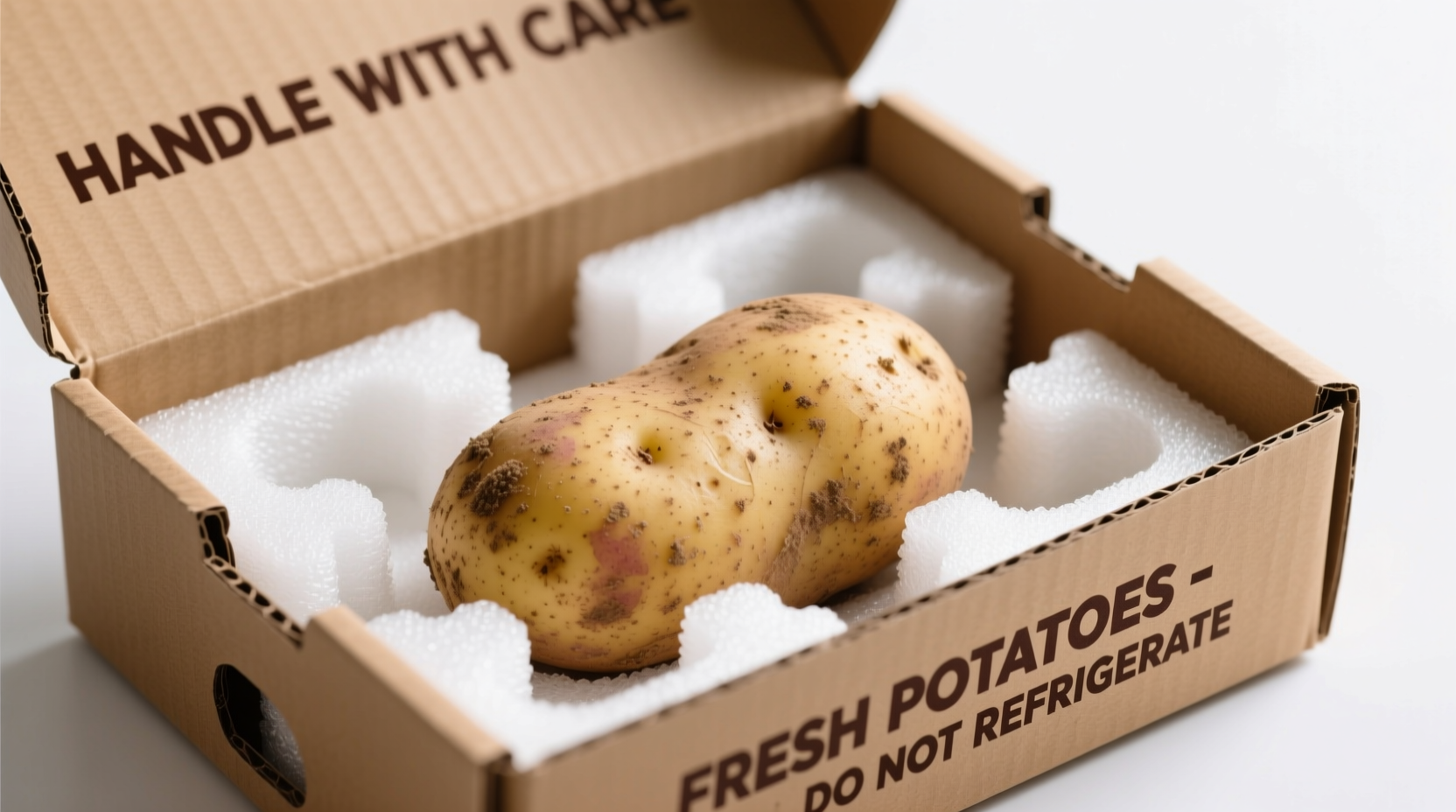Yes, you can legally mail a potato through the United States Postal Service (USPS) with proper packaging and adherence to shipping regulations. Potatoes are permitted as non-perishable agricultural items when properly prepared, though specific packaging requirements apply to prevent spoilage and damage during transit. The average cost ranges from $4.50 to $8.50 for domestic shipments depending on weight and service level.
Have you ever wondered whether it's actually possible to send a potato in the mail? Whether you're planning a quirky gift, participating in a tradition, or simply curious about postal regulations, this guide provides everything you need to know about mailing potatoes through the United States Postal Service. We'll cover the exact requirements, proper packaging techniques, cost considerations, and even share some fascinating historical context about potatoes in the postal system.
Understanding USPS Regulations for Mailing Produce
Mailing agricultural products like potatoes falls under specific USPS guidelines designed to prevent spoilage and protect the mailstream. According to the USPS International Mail Manual section C5, most agricultural products can be mailed domestically when properly prepared and packaged. Potatoes specifically are permitted as long as they're clean, dry, and not showing signs of decay.
The key regulation to understand is that while USPS allows mailing potatoes, they must be prepared to withstand transit without spoiling or creating messes. This means avoiding moisture retention and ensuring adequate ventilation in your packaging. Unlike perishable foods requiring refrigeration, potatoes can travel safely at room temperature when properly handled.
Proper Packaging Techniques for Mailing Potatoes
Successful potato mailing depends entirely on your packaging approach. Follow these professional techniques to ensure your spud arrives in perfect condition:
| Packaging Element | Recommended Approach | Avoid |
|---|---|---|
| Container | Rigid cardboard box with minimum 1/8" thickness | Envelopes or flimsy containers |
| Cushioning | Shredded paper or biodegradable packing peanuts | Plastic bags that trap moisture |
| Potato Preparation | Clean, dry, and cured for 2 weeks minimum | Wet potatoes or those with visible sprouts |
| Ventilation | Small air holes (1/8" diameter) every 2 inches | Completely sealed containers |
Start by selecting firm potatoes without blemishes or soft spots. Cure them for at least two weeks in a cool, dark place to harden the skin. Wrap each potato individually in dry newspaper, then place them in your prepared box with ample cushioning material. Include silica gel packets to absorb any unexpected moisture. Never ship potatoes that show signs of sprouting, as this indicates they're entering an active growth phase that could cause issues during transit.

Cost Analysis for Mailing Potatoes
Mailing a single potato typically falls within standard First-Class Package Service pricing. As of 2025, here's what you can expect to pay for domestic shipments:
- Under 4 ounces: $4.50 - $5.25 (First-Class Package)
- 4-12 ounces: $5.75 - $6.95 (First-Class Package)
- 12-16 ounces: $6.95 - $8.50 (First-Class Package)
- Over 16 ounces: Consider Priority Mail starting at $8.95
Consider adding tracking for $0.90-$1.50 for peace of mind, especially if mailing as a gift. International shipping costs vary significantly by destination, starting around $18.50 for basic international service to Canada or Mexico. Always check current rates on the USPS Postage Price Calculator before mailing.
Historical Context: The Potato Post Office Story
While mailing a single potato might seem unusual today, potatoes actually played a significant role in postal history. In 1895, the small town of Boys Town, Ohio (now part of Cleveland) established what became known as the "Potato Post Office." Local farmers needed a way to ship their potato harvests with proper documentation, so they created a dedicated postal facility that processed agricultural shipments.
This historical timeline shows how potatoes intersected with postal services:
- 1895: Boys Town, Ohio establishes dedicated "Potato Post Office" for agricultural shipments
- 1900: Over 50% of local mail consists of potato-related business correspondence
- 1912: USPS formalizes agricultural shipping guidelines following potato industry requests
- 1930s: Refrigerated rail cars reduce need for specialized potato postal services
- 2025: Modern packaging allows individuals to safely mail potatoes domestically
This historical precedent demonstrates that mailing potatoes isn't just permitted—it's part of American postal heritage. The original Potato Post Office building still stands today as a historical landmark, though it no longer processes potato shipments.
When Mailing Potatoes Makes Sense (And When It Doesn't)
While technically possible, mailing potatoes has specific appropriate use cases and limitations you should understand before proceeding:
Appropriate scenarios:
- Sending heirloom potato varieties to gardening friends
- Participating in educational programs about agriculture
- Sending novelty gifts with proper context (like "you're a-potato-lly great" cards)
- Mailing for historical reenactment purposes
Scenarios to avoid:
- International shipping (customs restrictions often apply)
- During summer months without climate-controlled shipping
- When sprouting has begun (indicates active growth)
- For commercial purposes without proper agricultural documentation
Consider alternatives like sending potato-themed gifts (potato-shaped stress balls, potato recipe books) if your situation falls into the "avoid" category. These provide similar novelty without the shipping complications.
Practical Tips for Successful Potato Mailing
Follow these professional tips to ensure your mailed potato arrives in perfect condition:
- Choose mature, firm potatoes with thick skins (Russets work best)
- Cure potatoes for 10-14 days in a cool, dark place before shipping
- Wrap each potato individually in dry newspaper
- Use a rigid box with at least 2 inches of cushioning on all sides
- Add silica gel packets to absorb moisture
- Puncture small ventilation holes in the box
- Mark the package "Fragile - Perishable Agricultural Product"
- Ship early in the week to avoid weekend delays
For best results, ship during cooler months and avoid extreme temperature changes. If mailing as a gift, include planting instructions in case the recipient wants to grow the potato. Remember that while potatoes can survive shipping, they're living organisms that may sprout or deteriorate if conditions aren't ideal.
Frequently Asked Questions
Can I mail a potato internationally?
International mailing of potatoes is generally prohibited due to agricultural restrictions. Most countries have strict regulations against importing raw agricultural products to prevent pest and disease transmission. Check with both your local postal service and the destination country's agricultural department before attempting international potato shipping.
How long will a mailed potato stay fresh?
When properly packaged, a mailed potato typically remains fresh for 2-3 weeks in transit. The key factors are using cured potatoes, providing adequate ventilation, and avoiding moisture buildup. Potatoes shipped during cooler months generally maintain freshness longer than those shipped in warm weather.
What happens if my mailed potato sprouts during transit?
Sprouting indicates the potato has entered an active growth phase, which is generally acceptable for mailing as long as the sprouts are small. However, significant sprouting or soft spots suggest the potato may be deteriorating. Properly cured potatoes with thick skins are less likely to sprout during standard shipping periods of 2-5 days.
Are there legal restrictions on mailing potatoes?
Domestic mailing of potatoes faces minimal restrictions as long as they're properly packaged. However, interstate shipping of agricultural products may require phytosanitary certificates in some cases. Always check current regulations on the USDA website or with your local agricultural extension office before mailing potatoes across state lines.











 浙公网安备
33010002000092号
浙公网安备
33010002000092号 浙B2-20120091-4
浙B2-20120091-4